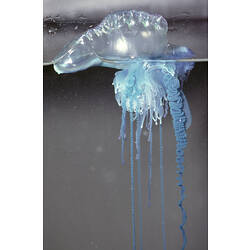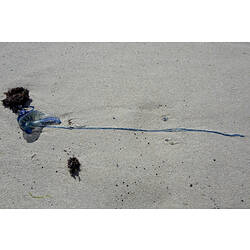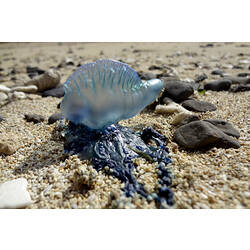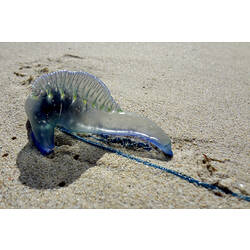General Description
Transparent clear to blue balloon float with a single, prominent long blue tentacle underneath. Float about 6 cm across, tentacles up to 1 m long.
Biology
These animals float on the surface with their tentacles hanging below in the water. The float can be orientated in one of two ways so that they are blown to the left (left-sailing) or to the right (right-sailing). This ensures that they do not all get blown in the same direction. Blue-bottles are not individual organisms; rather, they are colonies of multiple small zooids with different functions. The float is a single zooid. They catch small fish and planktonic crustaceans with their tentacle. Stings from the tentacle are very painful and require medical attention. Taxonomists are unsure how many species of Physalia exist; this species may be the same as the cosmopolitan Physalia physalis.
Distribution
South Pacific. Australian waters.
Habitat
Marine; open water, may drift near shore due to tides and winds.
More Information
-
Animal Type
-
Animal SubType
-
Brief Id
Transparent blue float, blue tentacle underneath.
-
Colours
Blue, Transparent
-
Habitats
-
Diet
Carnivore
-
Diet Categories
Fish
-
Hazards
Contact with the stinging tentacle will cause extremely painful stings. In extreme cases cardiac difficulties occur. Seek urgent medical attention if in doubt. Hot water (NOT vinegar) is recommended emergency treatment.
-
Endemicity
-
Commercial
No
-
Conservation Statuses
CITES: Not listed, FFG Threatened List: Not listed, DSE Advisory List: Not listed, IUCN Red List: Not listed
-
Depths
Shore (0-1 m), Shallow (1-30 m)
-
Water Column Locations
Midwater, Surface
-
Taxon Name
-
Scientific Author
(La Martiniere, 1787)
-
Common Name
Blue-bottle
-
Other Names
Portuguese Man-of-war
-
Phylum
-
Class
-
Subclass
-
Order
-
Family
-
Genus
-
Species Name
utriculus





